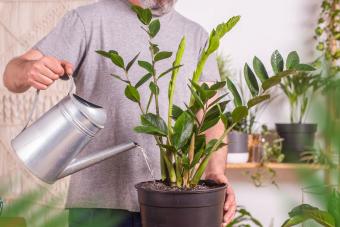
If you're looking for a low-maintenance, low-fuss houseplant that can tolerate a wide variety of conditions and prefers neglect over pampering (all while looking gorgeous, by the way) you might want to add a ZZ plant to your houseplant collection.
What Is ZZ Plant?
ZZ plant (full name: Zamioculcas zamiifolia) is native to west Africa. It's a drought-tolerant plant that grows from fleshy rhizomes and has a graceful, arching growth habit. They can grow to around 28 inches tall and nearly as wide, but they tend to grow fairly slowly.
In the mid-1990s, nurseries started stocking and selling ZZ plants to home gardeners. Before this, they were most commonly seen in offices and shopping malls, where their low maintenance and tolerance of a wide range of growing conditions was a benefit. It's an ideal plant for those who want to add a bit of greenery to their home without having to put in a lot of time. ZZ plant isn't overly picky, and in truth, the more you leave it alone, the happier it will be.
Despite rumors in the 2010s about ZZ plants causing cancer, they absolutely do not. However, all parts of the ZZ plant are toxic, so the plants should be kept away from children and pets. The sap from cut stems or leaves can also be irritating to the skin, so it's a good idea to wash your hands after handling the ZZ plant.

ZZ Plant Care
ZZ plant is one of the easiest houseplants in terms of the amount of care it needs.
Light
ZZ plant does well in every lighting condition except bright, indirect light. In very low light, the plant will still survive, but it may become leggy. So, really, anywhere except for directly in front of a bright southern or west-facing window would be ideal.
If you have an area with no natural light, ZZ plant will still grow well there as long as there's a source of artificial light, such as a lamp or overhead LED lighting.
Watering
Over-watering is the main cause of death for ZZ plants. Their fleshy rhizomes will rot in soil that's kept too wet. Water every two to three weeks during warmer months, and even less than that during the winter.
The shiny, almost waxy leaves can collect dust over time. A quick shower under lukewarm water will help, or you can gently wipe the leaves clean with a soft cloth.

Fertilizing
Because it naturally grows so slowly anyway, ZZ plant really doesn't need a lot in terms of fertilizing. Monthly feeding with a regular houseplant fertilizer during the warmer months is the most it will need, and if you forget, it really won't impact the plant that much. Some growers only fertilize their ZZs twice per year and have healthy, happy plants.
Repotting
ZZ really doesn't need to be repotted often. If you can see the rhizomes pushing against the sides of the pot it's growing in, or if you have your ZZ planted in a plastic pot and the pot is starting to bend out of shape, that's a sign that it's time to pot up to a larger size.
Soil
Any well-draining potting mix will do for ZZ plant. You just don't want anything too heavy that will hold on to moisture for a long time. Look for mixes that contain coir, perlite, or vermiculite.
Temperature and Humidity
ZZ plant isn't picky about temperature or humidity. The conditions inside your home will be fine. They do not tolerate cold well, however, so they need to be kept in an area warmer than 45 degrees and out of any very cold drafts.
ZZ Plant Problems and Pests
There aren't really any diseases or insects that affect ZZ plants (another sign of how truly low-maintenance they are). You'll still want to keep an eye out for common houseplant pests such as aphids, thrips, or mealybugs, but in general, pests don't tend to be much of a problem.
Mostly, you'll want to pay attention to the appearance of the leaves, which will tell you whether your ZZ is unhappy or not.
- Wilting and/or wrinkled leaves: Under-watering. Double-check by poking your finger into the soil. If it feels dry, your ZZ needs water.
- Yellowing and/or mushy leaves: Over-watering, and it's possible that the rhizomes are beginning to rot. Cut back on the water - ZZ only needs to be watered every two to three weeks.
- Curling leaves, or the plant leaning away from windows or another light source: The plant is getting too much bright light and is trying to shield itself from it. Move it a bit further away.
- Leggy growth, leaves spaced further apart: The plant isn't getting enough light. Move it closer to a window or give it supplemental lighting. This is really only an issue in the darkest corners of your home.
ZZ Plant Propagation
ZZ plant can be propagated in two different ways: by division and by taking cuttings.
Division
Division involves cutting off a piece of the plant's rhizome and transplanting it in a new pot. This is easily done when you're repotting your ZZ plant.
- Carefully remove the ZZ plant from its pot. At this point, it's easy to see the rhizomes and the stems that are growing from them.
- Select an area of the rhizome that has at least one stem growing from it. This will be your new ZZ plant.
- With a sharp knife, cut the section you've selected off of the main plant. Place it in a pot with fresh potting mix. Usually, a four-inch diameter pot is a good size for this.
- Repot the mother plant, adding fresh soil if needed.
- Water both the mother plant and the division well.
- Keep your new ZZ plant in bright, indirect light to get it off to a healthy start.

Propagation
Propagating by cuttings is easy, but growth will be much slower.
- With a clean knife or pruners, cut a section of stem from the mother plant that has at least two sets of leaves.
- Dip the cut end of the stem into rooting hormone, and then place it into fresh soil in a three to four-inch pot.
- Firm the soil around the stem cutting and water it in gently.
- Place the cutting in bright indirect light.
- You'll need to water this cutting more often than you'd water the mother plant, since it hasn't developed its rhizomes yet. This can take anywhere from six to nine months.
Easy ZZ
Whether you have a bright room or a fairly dim one, ZZ plant will grow with very little coddling from you. Keep in mind that ZZ thrives on neglect, so you can enjoy this plant and the beauty it provides, all with very little effort.







